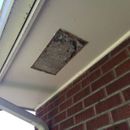Attic venting conundrum
I bought my house in August 2015. It’s a 1950s ranch, low slope roof with some pretty poorly done additions. The attic is chopped into 3 “sub-attics” that are not continuous with each other. The venting of all three was/is basically nonexistent. The previous home owner had 18 inches of cellulous blown onto the attic floor.
Unfortunately, no work was done to ensure airflow from the one (1) soffit vent in one of the subattics. This subattic has one sofit vent that is completely clogged with cellulose. The entire soffit is filled densely with cellulose. The roof angle is slow low that I cannot get to the soffit from the inside to clear it. I can clear some from the outside but I’m worried about pulling too much away from the top plate. As for exhaust in this subattic, I’ve got one small gable vent.
I’d like to increase ventilation to get rid of some of the heat in the summer. There is no evidence of moisture issues. There has been a lot of air/vapor sealing done.
I’m going to add some roof vents; question is about how to go about intake.
Possibilities I’m considering:
1. Remove soffit panels and do my best to create airflow without pulling too much insulation away from the floor of the attic, i.e., thinning it out and thus reducing R value.
2: Putting a large vent in the gable wall down close to the floor of the attic, and this being the only intake.
The area is about 350 square feet. I’m in Denver – it’s pretty dry here.
Any and all advice will be appreciated. Thanks
GBA Detail Library
A collection of one thousand construction details organized by climate and house part










Replies
John,
Attic venting is not intended to lower attic temperatures during the summer. Moreover, even if you wanted to lower attic temperatures with your soffit vents, this method would be ineffective.
You wrote that "there is no evidence of moisture issues." It doesn't sound as if you have any problems. Leave well enough alone -- you don't have to do anything.
For more information on this issue, see All About Attic Venting.